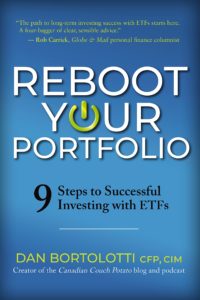Special to the Financial Independence Hub
Before I go any further, I want to be clear that this isn’t a case of me having a “smarter” portfolio where I’m actively trading to beat the market. I steer people to low-cost passive investing and that’s what I use myself. The main difference between me and other do-it-yourself (DIY) investors is the degree to which I’ve built most of the complexity of my portfolio into an elaborate spreadsheet that alerts me by email when I need to take some action. I’m happy to automate complexity in this way and let the spreadsheet tell me what to do. I can safely ignore my portfolio for months without worry.
Pay yourself first
Bortolotti says “‘Pay yourself first’ has become a cliché because it works.” “Sure, you could wait until the end of the month and then save whatever is left after paying all your expenses.” “People following this approach rarely wind up with any surplus cash.” “Make your savings a fixed expense, too, and you’ll be well on your way to meeting your investment goals. It’s impossible to overstate how important this is.”
This is excellent advice. I recommend it to my sons. My wife and I never followed it ourselves. From a young age we were used to only spending money on necessities. It’s taken us decades to get used to spending money more freely. During our working years, our savings rate bounced around, but it was rarely below 20%, and reached 80% for a while when the family income rose and the kids cost us less. This wasn’t a case of us scrimping or having a savings target. That’s just what was left after we bought what we needed and wanted.
Expected future returns
Vanguard research showed “that most of the techniques people employ to forecast future stock returns are utterly worthless.” “So don’t get clever when you’re trying to estimate stock returns in your own financial plan. That average over the very long term — about 5% above inflation — is a reasonable enough assumption.”
As a retiree, I find it wise to back off from the long term average of 5% and use 4%; I’d rather spend a little less starting now than be forced to spend a lot less in the future if stocks disappoint.
Bortolotti is right that P/E ratios have little predictive value. I made this point myself recently. However, long-term data show a consistent weak correlation between P/E levels and future stock returns. This effect is almost unmeasurable over a year, and is very weak over a decade. However, it builds over multiple decades. I model this effect by assuming that P/E levels will decline to a more normal level by the time I turn 100, and corporate earnings will grow at an average rate of 4% annually above inflation over that time. At the time of writing, this amounts to assuming stocks will return 2.6% above inflation over the rest of my investing life. The missing 1.4 percentage points comes from the assumed drop in P/E levels over the decades.
The difference between my assumption of 2.6% and Bortolotti’s 5% is substantial. It’s probably not important to those still a decade or more away from retirement; they have time to try to save more, work longer, or plan a more modest retirement. Current retirees are another matter. If they assume their stock allocation will beat inflation by 5%, high spending in early retirement could leave them with meagre later years.
Factor Investing
Investment research over the decades has shown that stocks with certain properties have outperformed. These properties are called “factors,” and this whole area is sometimes referred to as “smart beta.” Some well known factors are value (“stocks with low prices relative to their fundamentals”), small cap (small companies whose market capitalization is below some threshold), and momentum (“when stocks rise in price, they continue that trend for months before eventually settling back to earth”).
Although the research behind factor investing is solid, there is no guarantee that factors will outperform in the future. There is good reason to believe that once people routinely invest in factors, the outperformance will decline or disappear. Bortolotti makes a number of other good arguments for avoiding smart beta. For myself, I decided years ago that the most solid factor was the set of stocks with both the small factor and the value factor. Vanguard has a low-cost ETF for small value U.S. stocks with the ticker VBR. So, for better or worse, I chose to make VBR part of my asset allocation. Of all my deviations from Bortolotti’s advice, I find this one the hardest to defend.
Glidepath
The term “glidepath” refers to the path of your stock allocation percentage over time. Bortolotti writes “there are occasions when it is appropriate to reconsider your asset allocation. Your time horizon gets a little shorter every year, so you will want to reassess your portfolio’s risk level as you get older.”
I agree, but rather than reevaluating my portfolio’s risk level periodically, I’ve chosen a glidepath in advance. My allocation to stocks drops slowly over time. The process has some complexity, but that’s all buried in my spreadsheet. If my slowly declining stock allocation happens to trigger the need to rebalance, I’ll get an email telling me what to do.
I’ve also decided to increase my fixed income allocation (cash, GICS, and short-term bonds) in proportion to the stock market’s P/E when this level is over a fixed threshold. This is built into my spreadsheet so that if rising stock markets trigger the need for me to rebalance, I get an alert email. Without this adjustment, my fixed income allocation would be about 20%, but the adjustment moves it up to 24% at the time of this writing. This may not seem like much of an adjustment, but it’s large in dollar terms. For the stock market P/E to get up to its current lofty level, stock prices had to rise substantially. So, 24% of a larger portfolio is a lot more dollars than 20% of a smaller portfolio.
In a technical sense, this part of my investing spreadsheet amounts to market timing. However, the shifts are subtle, they take place over long periods, and they are fully automated. I see this as very different from a nervous investor who suddenly decides to sell all his stocks. I tend to think of this added money in fixed income investments when stocks are expensive as my answer to the question “Why keep playing the investment risk game when you’ve already won?”
U.S.-listed ETFs and Asset Location
“US-listed ETFs offer some advantages over those from Canadian providers.” “The most obvious is lower fees.” They are also “more tax-efficient in RRSPs [and RRIFs].” “US securities held in RRSPs are exempt from [dividend] withholding taxes, thanks to a tax treaty between [the U.S. and Canada].” This treaty doesn’t apply for Canadian-listed ETFs, even when they hold the same assets as U.S.-listed ETFs.
One downside of using U.S.-listed ETFs in your RRSPs is the need to trade in U.S. dollars. This creates the need for either expensive currency exchanges or cheaper but complex Norbert’s Gambit currency exchanges. Another downside is the complexity of trying to maintain near optimal asset location choices across your entire portfolio. My spreadsheet figures this out for me, but I’d be frustrated if I had to figure it out every time I needed to trade. Most DIY investors would struggle as well.
“I recommend that do-it-yourself investors stick to using ETFs that trade on the Toronto Stock Exchange.” I make the same recommendation. Bortolotti allows that “If you have large foreign equity holdings in your RRSP, and you’re an experienced investor who is comfortable with the added complexity, then you can make a good argument for US-listed funds, but only if you have US cash to invest or you’re able to convert your currency cheaply.”
I’ve recommended to my sons that they stick to Canadian-listed ETFs, but I use U.S.-listed ETFs in my own RRSPs. The monthly savings my wife and I get from U.S.-listed ETFs and careful asset location choices is roughly equal to half of what we pay in income taxes each year since we retired. To save this much, I’m happy to let my spreadsheet do the work. I’d probably just use a single asset allocation ETF in all my accounts if I didn’t have the spreadsheet.
Conclusion
I’ve taken my shot at defending the ways my portfolio deviates from the advice I give others and the advice Bortolotti gives in his book. However, I still consider myself to be strongly in the low-cost index investing camp. In my view, those who pick some stocks on the side or time the market based on hunches are going further afield.
 Michael J. Wiener runs the web site Michael James on Money, where he looks for the right answers to personal finance and investing questions. He’s retired from work as a “math guy in high tech” and has been running his website since 2007. He’s a former mutual fund investor, former stock picker, now index investor. This blog originally appeared on his site on Nov. 10, 2021 and is republished on the Hub with his permission.
Michael J. Wiener runs the web site Michael James on Money, where he looks for the right answers to personal finance and investing questions. He’s retired from work as a “math guy in high tech” and has been running his website since 2007. He’s a former mutual fund investor, former stock picker, now index investor. This blog originally appeared on his site on Nov. 10, 2021 and is republished on the Hub with his permission.


